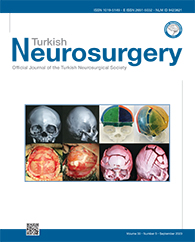2Bursa Uludag University, Inegol Vocation School, Bursa, Turkey
3Bursa Uludag University, Faculty of Medicine, Department of Medical Biology, Bursa, Turkey
4Bursa Uludag University, Faculty of Dentistry, Department of Fundamental Sciences, Bursa, Turkey
5Bursa Uludag University, Faculty of Medicine, Department of Neurosurgery, Bursa, Turkey
6Bursa Uludag University, Faculty of Medicine, Department of Pathology, Bursa, Turkey DOI : 10.5137/1019-5149.JTN.41845-22.2 AIM: To describe the role of metastasis-associated lung adenocarcinoma transcript 1 (MALAT1) in glioblastoma (GB) progression in patients concurrently diagnosed with diabetes mellitus (DM).
MATERIAL and METHODS: Formalin-fixed paraffin-embedded (FFPE) tumor samples of 47 patients diagnosed with GB only and 13 patients diagnosed with GB and DM (GB-DM) were enrolled in this study. Data for p53 and Ki67 immunohistochemical staining of the tumors and blood HbA1c levels of patients with DM were retrospectively collected. MALAT1 expression was assessed using quantitative real-time polymerase chain reaction.
RESULTS: The coexistence of GB and DM induced the nuclear expression of p53 and Ki67 compared with GB only. MALAT1 expression was higher in GB-DM tumors than in GB only tumors. The expression of MALAT1 and HbA1c levels were positively correlated. Additionally, MALAT1 was positively correlated with tumoral p53 and Ki67. The disease-free survival of patients with GB-DM with high MALAT1 expression was shorter than that of those diagnosed with GB only and with a lower MALAT1 expression.
CONCLUSION: Our findings suggest that one of the mechanisms of the facilitating effect of DM on GB tumor aggressiveness is via MALAT1 expression.
Keywords : Diabetes mellitus, Glioblastoma, MALAT1, HbA1c




